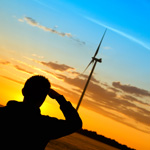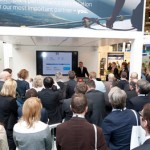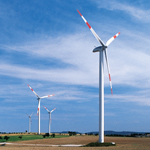
The WWF logo
Recently some national governments in Europe have made changes to their support mechanisms for renewable energies that have created an environment of insecurity for the wind energy sector. However, a new report by the WWF says that such policies create needed certainty for renewable energy investors, backing up a view held by EWEA.
Uncertainty about future policy support for renewable energy in key markets such as the UK, Italy and France has contributed to a notable drop in investment levels across the EU. However, On Picking Winners, a report written by Dr Rob Gross of Imperial College London, argues that given the numerous benefits of renewable energy, it is vital that the EU and its member state governments provide the support needed to ensure it plays its full part in decarbonising the EU’s energy system.
“Without targeted and proportionate policies supporting our renewables industry, we will miss out on the opportunity rapidly to reduce the costs of emerging renewable technologies, and will fail to capitalise on the promising economic growth opportunities that the sector has to offer in the EU,” says Imke Lübbeke, Senior Renewable Energy Policy Officer at WWF European Policy Office.

Francesco Starace, EWEA 2013 Chair and CEO of Enel Green Power SpA
With three months to go until Vienna becomes a hive of wind energy activity at the EWEA Annual Event, we caught up with Conference Chair Francesco Starace, CEO of Enel Green Power SpA, to find out what he thinks is hot in wind energy right now…
How would you describe the current wind power market in Europe and what do you think the short-term outlook is?
The context where the EU wind industry is currently operating is one of economic downturn. Yet, the strong links between economic activity, energy supply and demand and energy investments, make it more difficult to understand the condition and timing of recovery. It will likely take other three or four years for the EU economy to recover and for the gap between power supply and demand to close and until that time major growing opportunities will be unlikely in mature European Markets. Despite the concerns on the short term outlook, positive signals are coming from promising markets in Eastern Europe. Meanwhile there is still room for EU member states to stimulate growth in renewables by making progress on the targets planned for 2020 in National Renewable Energy Action Plans through increasing coordination and a sound policy framework at European and national level.
 A new UK-wide poll indicating that more than two-thirds of respondents would favour a community-owned wind turbine close to their home rather than a shale gas well is bound to raise questions about Chancellor George Osborne’s proposed “dash for gas.”
A new UK-wide poll indicating that more than two-thirds of respondents would favour a community-owned wind turbine close to their home rather than a shale gas well is bound to raise questions about Chancellor George Osborne’s proposed “dash for gas.”
The Guardian reported Tuesday that the poll, conducted by ICM Survey, shows only coal and nuclear are less popular that shale gas.
When asked to choose between having the two energy sources within two miles of their home, the Guardian noted, 67% of respondents favoured a turbine, compared to just 11% who would support the gas development.
 In just over three months’ time thousands of wind energy professionals will gather in Vienna alongside EU and national level decision makers, financeers, technology specialists and others at the European Wind Energy Association’s Annual Event, EWEA 2013.
In just over three months’ time thousands of wind energy professionals will gather in Vienna alongside EU and national level decision makers, financeers, technology specialists and others at the European Wind Energy Association’s Annual Event, EWEA 2013.
But what will everybody be talking about at the event? Yesterday, I spoke to some of the conference’s lead session chairs to get a glimpse of just one of the topics that will make Vienna buzz next February…
Turbine technology – just how big can turbines get? Now that the 5 MW barrier has been broken, what’s the next step? While some said the “sky is the limit” others pointed to practicalities like the ability to transport large turbine components, especially offshore. No vessel in the world has yet been designed to transport the largest of turbines one insider told me. Others noted that onshore, turbine size probably wouldn’t get much bigger due to possible public acceptance issues.
 Aviation constraints are a huge issue for the wind industry. In 2011, EWEA carried out a survey and found that 19 GW of wind projects were blocked by radar difficulties in the UK, Finland, Sweden, Germany, Czech Republic, France, Spain, Greece and Ireland.
Aviation constraints are a huge issue for the wind industry. In 2011, EWEA carried out a survey and found that 19 GW of wind projects were blocked by radar difficulties in the UK, Finland, Sweden, Germany, Czech Republic, France, Spain, Greece and Ireland.
Many difficulties for wind farm developers come from conflicts with obsolete radar equipment and problems associated with keeping track of system upgrades over time. According to Renewable UK, for example, half of all wind farm developments in the UK will face objections from aviation stakeholders on the grounds of radar interference, obstruction or impact to low flying. However, a new promising radar technology could be one way to solve some of these problems.
Cambridge Airport in the south-east of England has signed a deal to use so-called 3D holographic radar technology. Its creators claim that the technology is the first of its kind that can reliably discriminate between wind turbines and aircraft based on differences in their behaviour.








 Comments
Comments



